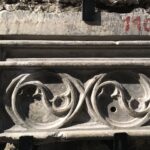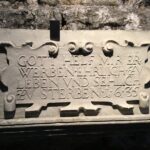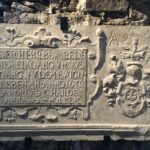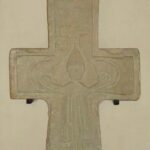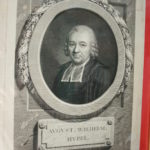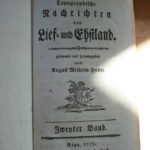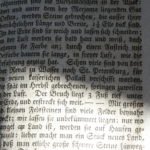Orgita dolomite is the main raw material of our small stone factory.
The most famous work made of this stone is located in Tallinn, on the outside of the front gate of Paksu Margareeta. In 1529, the author of the coat of arms in the flame style is master Gert Koningk from Münster, who was also in office at the Oleviste kirik .
As you can see, over the centuries, the stone has successfully defied both rain from the eaves and winter frost. Several Orgita dolomite tombstones are exhibited in the Tombstone Museum:
The dialects here are mentioned for the first time already in the XIII-XIV centuries in connection with the construction of the Märjamaa church. A rare stone cross with the image of a bishop and drinking horn preserved in the Vigala church also proves the use of dolomite in this period.
We can find a colorful description of the Orgita dolomite in the pen of August Wilhelm Hupel, a prolific writer and provost of Põltsamaa;
He bequeathed to future generations precious descriptions of the economic, geographical, natural and various other conditions of Estonia and Livonia in a 4-volume work “Topographische Nachrichten von Lief- und Ehstland” (1772–1785) where he in the volume of 1777 wrote:
“The most famous is the breaking stone in the land of Orgita manor near Märjamaa in Lääne County. Apart from the considerable length and width of the broken stone, the layers are also very thick. In the ground, Orgita stone is soft and can be cut. When exposed to air, the head becomes hard and white. Under oil paint, as experience shows, the stone lasts a long time. From here it has already been shipped a lot across the Tallinn waterway along St. For the use of the new imperial palace in St. Petersburg.”
The first geological description of the dolostone here was prepared by F. Schmidt in 1858 and he called it Märjamaa sandstone (Merjamascher Sandstein) and that they are quarried a lot and transported far away. Thus, over the centuries, Orgita stone has been used in the construction of many churches, including Tallinn Oleviste and Toomkirik; when carving altars, crosses, grave monuments and coat of arms reliefs.
The technical properties of Orgita dolomite are good. In terms of its good workability, the Orgita dolomite is similar to the widely known Kaarma dolomite of Saaremaa, but externally it is considerably more uniform: there are no large pyrite marks.
I will also add here some unpublished interesting studies that deal more broadly with the use of limestone, but often also Orgita dolomite, in Estonian architecture; interestingly, the use of limestone and dolomite has been integrated over the centuries:
Von Nottbeck, Eugen; Neumann, Wilhelm. Geschichte und Kunstdenkmäler der Stadt Reval. Zweite
Delivery: Kirchliche Kunst. Grabsteine Revals. Rev: Hans Kluges Verlag, 1899.
Arnek, Estonian cyclists. Directory. Tartu, 2015.
U. From Treisalt, about the peculiarities of Tallinn’s stele art. Inventory of early modern window pillars. Bachelor thesis.
Tallinn: Estonian Academy of Arts, 2019.
T. Parmakson, G. Parmakson. Republic’s medieval raid portals
inventory. Gift shop district. Tallinn, 1983.
I am also adding here a potential major project, for the realization of which all stone processors in Estonia could contribute; even a fraction of the restoration of Baroque-era Narva between the khrustsovkas would give a tangible ideological message to the city residents about vatniks – what you built and what you destroyed:
https://kertkits.ee/narva-vanalinna-taastamine.html
Architect Kert Kits is attractive, exciting and convincing in his vision.
A more comprehensive all-Union study to find out the potential of the deposit was carried out here in the mid-1950s with the desire to find a resource for the construction of the socialist national economy, the creative intervention of pro-Estonian geologists in the research results forced the abandonment of mass mining /prof. According to Rein Einasto/.
In the Orgita limestone quarries, Orgita dolostone is broken more and more today, often unfortunately mainly for the use of crushed stone.
We started the Gildemann stone workshop in 1991 in Parkhof semi-manor. We built a beautiful workshop building, we hired the first employees in 1992. At this point, we have to thank our first employee, Mr. Luige Ennu, whose wealth of experience was an irreplaceable help to us in the early days, and his son Nils Luiget, for whom all challenges were solved with pleasure. In the early years we used large metal cutting machines with a very large craft section, today all production has been moved to cnc machines.
For decades, our main activity has been the fulfillment of complex and labor-intensive stone orders.
Fireplaces, columns, facade elements, monuments, flower trays, fountains, window sills, also cobblestone, etc. are our main product items to this day.
Our company was named after our great-aunt Ms. Anna Gildemann /b. Kulikowsky/ who, in addition to his rich library and material heritage, bequeathed to us a love for all old things.
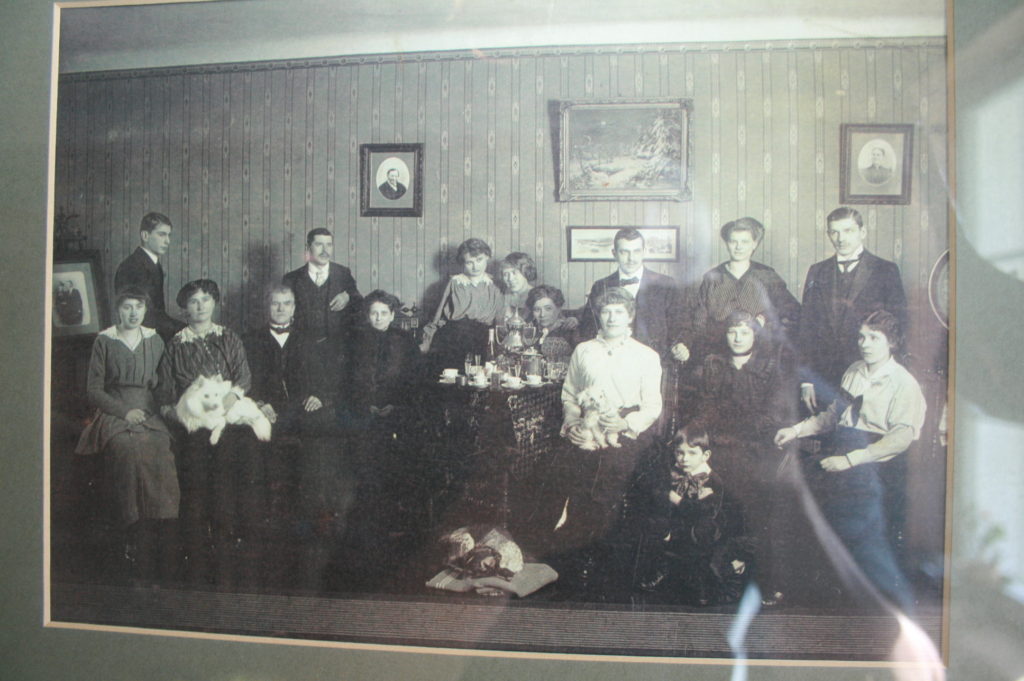
In the picture, the Kulikovsky family, in the picture from the bottom right is the second Mrs. Gildemann in 1913. in their apartment on Laia street in Tallinn. The First World War ended the younger brother Willy’s life path – according to legend, the white horse of a soldier who had gone on reconnaissance somewhere in Bessarabia came back without a rider. II MS scattered the family, Mrs. Sitting at Gildemann’s feet, Axel, the young gentleman with the shleif, was the only link to relatives who fled to the West during the Russian era.
Added video about the history of limestone in the first part, more about Gildemann in the second part:


